Abstract
Doxorubicin (former generic name, adriamycin), a highly effective anticancer drug, produces cardiotoxicity, which limits its therapeutic potential. The mechanism of this cardiotoxicity has remained elusive. Our data suggest that this toxicity could involve doxorubicinol, the primary circulating metabolite of doxorubicin. Doxorubicinol was markedly more potent than doxorubicin at compromising both systolic and diastolic cardiac function. Similarly, doxorubicinol was much more potent than doxorubicin at inhibiting the calcium pump of sarcoplasmic reticulum [ATP phosphohydrolase (Ca2+-transporting), EC 3.6.1.38], the Na+/K+ pump of sarcolemma [ATP phosphohydrolase (Na+/K+-transporting), EC 3.6.1.37], and the F0F1 proton pump of mitochondria [ATP phosphohydrolase (H+-transporting, EC 3.6.1.34]. Our finding that this highly toxic metabolite was produced by cardiac tissue exposed to doxorubicin suggests that doxorubicinol could accumulate in the heart and contribute significantly to the chronic cumulative cardiotoxicity of doxorubicin therapy. Our observation that doxorubicin was more potent than doxorubicinol in inhibiting tumor cell growth in vitro suggests that the cardiotoxicity of doxorubicin is dissociable from its anticancer activity.
Full text
PDF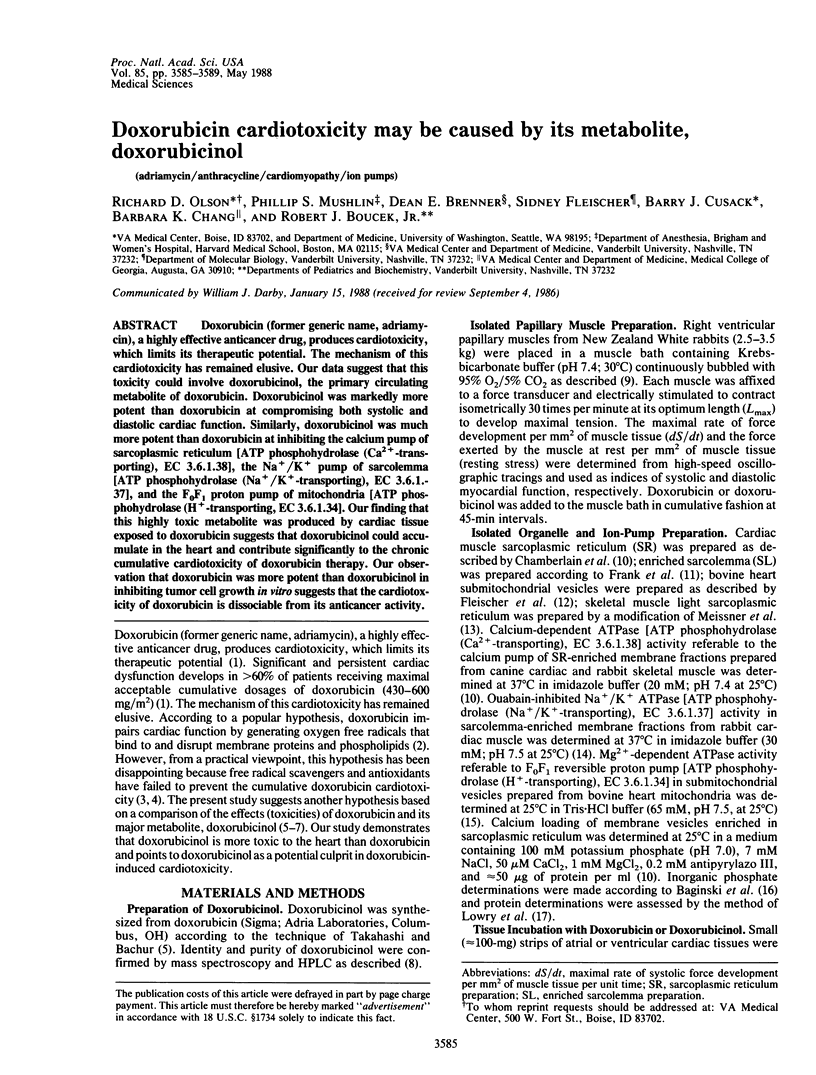
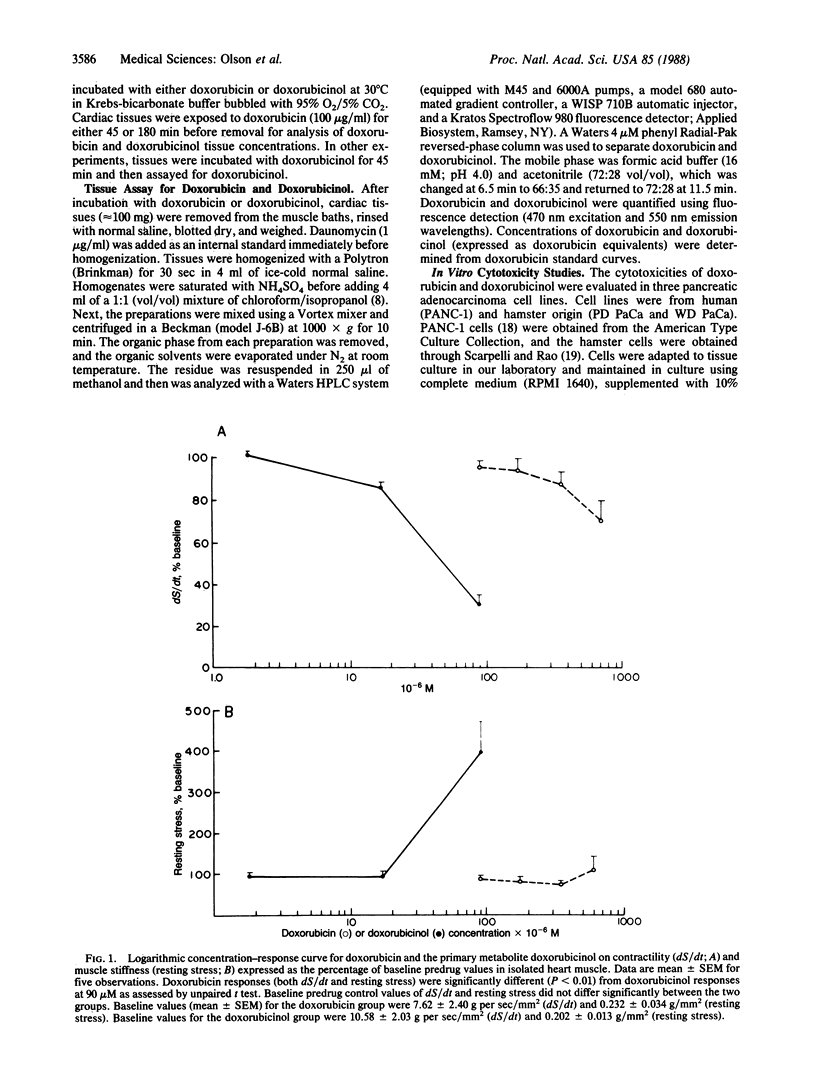
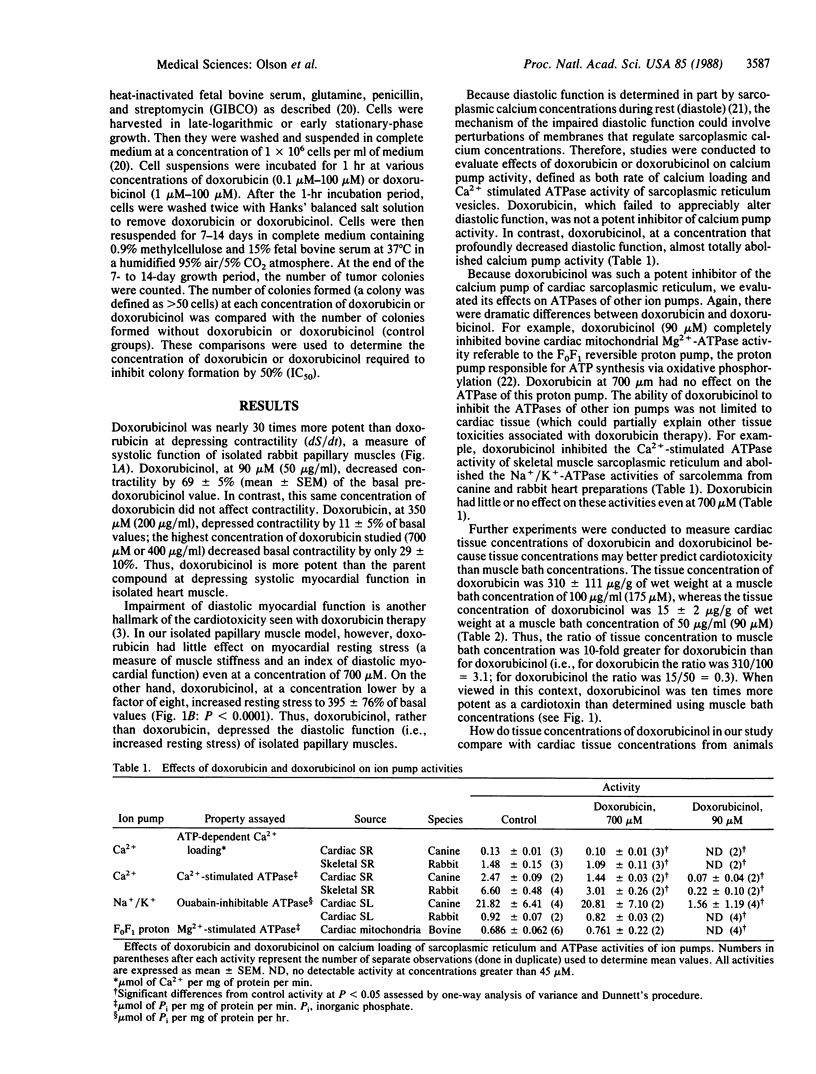
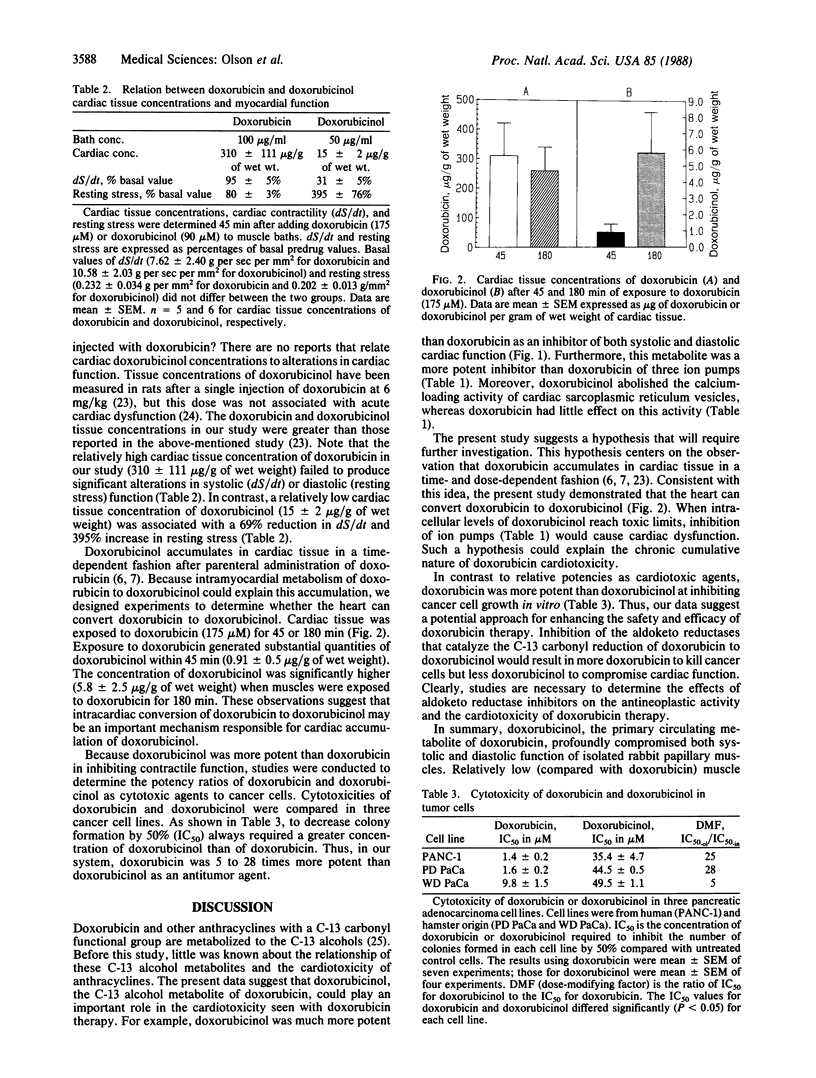
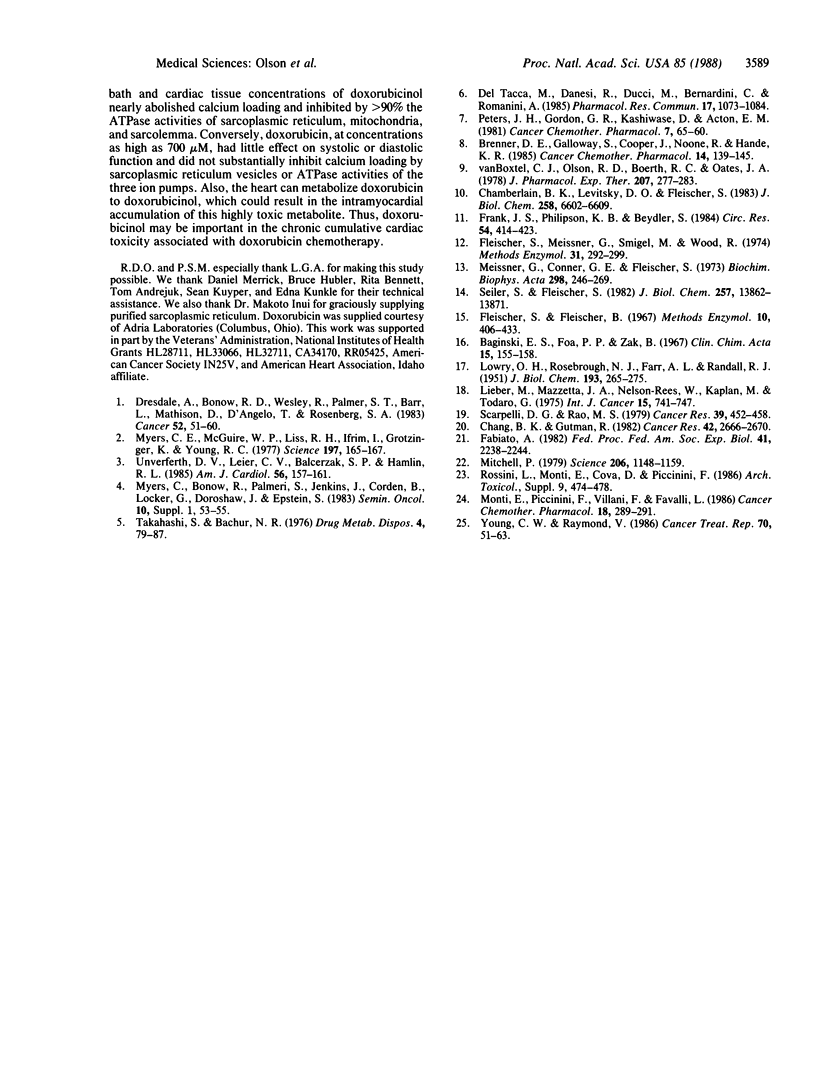
Images in this article
Selected References
These references are in PubMed. This may not be the complete list of references from this article.
- Brenner D. E., Galloway S., Cooper J., Noone R., Hande K. R. Improved high-performance liquid chromatography assay of doxorubicin: detection of circulating aglycones in human plasma and comparison with thin-layer chromatography. Cancer Chemother Pharmacol. 1985;14(2):139–145. doi: 10.1007/BF00434353. [DOI] [PubMed] [Google Scholar]
- Chamberlain B. K., Levitsky D. O., Fleischer S. Isolation and characterization of canine cardiac sarcoplasmic reticulum with improved Ca2+ transport properties. J Biol Chem. 1983 May 25;258(10):6602–6609. [PubMed] [Google Scholar]
- Chang B. K., Gutman R. Chemotherapy of pancreatic adenocarcinoma: initial report on two transplantable models in the Syrian hamster. Cancer Res. 1982 Jul;42(7):2666–2670. [PubMed] [Google Scholar]
- Del Tacca M., Danesi R., Ducci M., Bernardini C., Romanini A. Might adriamycinol contribute to adriamycin-induced cardiotoxicity? Pharmacol Res Commun. 1985 Nov;17(11):1073–1084. doi: 10.1016/0031-6989(85)90113-4. [DOI] [PubMed] [Google Scholar]
- Dresdale A., Bonow R. O., Wesley R., Palmeri S. T., Barr L., Mathison D., D'Angelo T., Rosenberg S. A. Prospective evaluation of doxorubicin-induced cardiomyopathy resulting from postsurgical adjuvant treatment of patients with soft tissue sarcomas. Cancer. 1983 Jul 1;52(1):51–60. doi: 10.1002/1097-0142(19830701)52:1<51::aid-cncr2820520111>3.0.co;2-#. [DOI] [PubMed] [Google Scholar]
- Fabiato A. Calcium release in skinned cardiac cells: variations with species, tissues, and development. Fed Proc. 1982 May;41(7):2238–2244. [PubMed] [Google Scholar]
- Fleischer S., Meissner G., Smigel M., Wood R. Preparation of submitochondrial vesicles using nitrogen decompression. Methods Enzymol. 1974;31:292–299. doi: 10.1016/0076-6879(74)31030-0. [DOI] [PubMed] [Google Scholar]
- Frank J. S., Philipson K. D., Beydler S. Ultrastructure of isolated sarcolemma from dog and rabbit myocardium. Comparison to intact tissue. Circ Res. 1984 Apr;54(4):414–423. doi: 10.1161/01.res.54.4.414. [DOI] [PubMed] [Google Scholar]
- LOWRY O. H., ROSEBROUGH N. J., FARR A. L., RANDALL R. J. Protein measurement with the Folin phenol reagent. J Biol Chem. 1951 Nov;193(1):265–275. [PubMed] [Google Scholar]
- Lieber M., Mazzetta J., Nelson-Rees W., Kaplan M., Todaro G. Establishment of a continuous tumor-cell line (panc-1) from a human carcinoma of the exocrine pancreas. Int J Cancer. 1975 May 15;15(5):741–747. doi: 10.1002/ijc.2910150505. [DOI] [PubMed] [Google Scholar]
- Meissner G., Conner G. E., Fleischer S. Isolation of sarcoplasmic reticulum by zonal centrifugation and purification of Ca 2+ -pump and Ca 2+ -binding proteins. Biochim Biophys Acta. 1973 Mar 16;298(2):246–269. doi: 10.1016/0005-2736(73)90355-6. [DOI] [PubMed] [Google Scholar]
- Mitchell P. Keilin's respiratory chain concept and its chemiosmotic consequences. Science. 1979 Dec 7;206(4423):1148–1159. doi: 10.1126/science.388618. [DOI] [PubMed] [Google Scholar]
- Monti E., Piccinini F., Villani F., Favalli L. Myocardial contractility and heart pharmacokinetics of adriamycin following a single administration in rat. Cancer Chemother Pharmacol. 1986;18(3):289–291. doi: 10.1007/BF00273406. [DOI] [PubMed] [Google Scholar]
- Myers C. E., McGuire W. P., Liss R. H., Ifrim I., Grotzinger K., Young R. C. Adriamycin: the role of lipid peroxidation in cardiac toxicity and tumor response. Science. 1977 Jul 8;197(4299):165–167. doi: 10.1126/science.877547. [DOI] [PubMed] [Google Scholar]
- Myers C., Bonow R., Palmeri S., Jenkins J., Corden B., Locker G., Doroshow J., Epstein S. A randomized controlled trial assessing the prevention of doxorubicin cardiomyopathy by N-acetylcysteine. Semin Oncol. 1983 Mar;10(1 Suppl 1):53–55. [PubMed] [Google Scholar]
- Peters J. H., Gordon G. R., Kashiwase D., Acton E. M. Tissue distribution of doxorubicin and doxorubicinol in rats receiving multiple doses of doxorubicin. Cancer Chemother Pharmacol. 1981;7(1):65–69. doi: 10.1007/BF00258216. [DOI] [PubMed] [Google Scholar]
- Rossini L., Monti E., Cova D., Piccinini F. Determination of doxorubicin and doxorubicin-3-ol in rat heart. Arch Toxicol Suppl. 1986;9:474–478. doi: 10.1007/978-3-642-71248-7_102. [DOI] [PubMed] [Google Scholar]
- Scarpelli D. G., Rao M. S. Transplantable ductal adenocarcinoma of the Syrian hamster pancreas. Cancer Res. 1979 Feb;39(2 Pt 1):452–458. [PubMed] [Google Scholar]
- Seiler S., Fleischer S. Isolation of plasma membrane vesicles from rabbit skeletal muscle and their use in ion transport studies. J Biol Chem. 1982 Nov 25;257(22):13862–13871. [PubMed] [Google Scholar]
- Takanashi S., Bachur N. R. Adriamycin metabolism in man. Evidence from urinary metabolites. Drug Metab Dispos. 1976 Jan-Feb;4(1):79–87. [PubMed] [Google Scholar]
- Unverferth D. V., Leier C. V., Balcerzak S. P., Hamlin R. L. Usefulness of a free radical scavenger in preventing doxorubicin-induced heart failure in dogs. Am J Cardiol. 1985 Jul 1;56(1):157–161. doi: 10.1016/0002-9149(85)90585-5. [DOI] [PubMed] [Google Scholar]
- Young C. W., Raymond V. Clinical assessment of the structure-activity relationship of anthracyclines and related synthetic derivatives. Cancer Treat Rep. 1986 Jan;70(1):51–63. [PubMed] [Google Scholar]
- van Boxtel C. J., Olson R. D., Boerth R. C., Oates J. A. Doxorubicin: inotropic effects and inhibitory action on ouabain. J Pharmacol Exp Ther. 1978 Nov;207(2):277–283. [PubMed] [Google Scholar]



